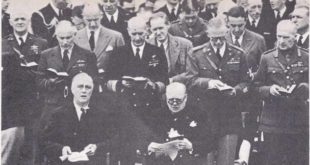AS THE SKY darkened over Moscow on the evening of March 5, 1953, thousands of people waited in line before a building called the Hall of Columns. Some of them wept; some carried flowers. Moving slowly and silently toward the entrance, they could see a forty-foot portrait of Premier Josef Stalin, framed in gold, which hung on the side of the building. News of Stalin’s death had been announced late that afternoon and now he lay in state in an immense room whose marble columns were draped in flags of red and black. Four days later, Stalin’s body was carried to the tomb on Red Square where lay the body of Lenin, the founder of the Soviet Union. At twelve noon, when Stalin’s body was placed beside that of Lenin, cannon were fired in every city of Russia. Cars, trucks, busses and trains stopped for five minutes, while people repeated the phrase, “Proshe, oteytz”–“Farewell‚ father” and so the Russians took leave of the man who had ruled them for twenty-nine years. Those twenty-nine years had been among the most eventful and terrible in history, not only for Russia, but for the world. Under Stalin, the Soviet Union had been industrialized. It had fought off an invasion from Nazi Germany and after the war, had established a mighty Communist empire in Eastern Europe and the Balkans. A once backward country had become one of the greatest powers on earth, but the price, in lives and liberty, had been unbelievably high. Millions of people had been killed for resisting Stalin’s program of rapid industrialization, or for disagreeing with him on political issues — or simply because Stalin had suspected them of disloyalty. The older that Stalin grew, the more tyrannical he became. In 1946, when the cold war with the West began, …
Read More »Victory in Europe 1941 – 1945
Even before Pearl Harbour, there had been cooperation between the United States and Britain. In August of 1941, President Roosevelt and Prime Minister Churchill met secretly, on a cruiser at sea off the coast of Newfoundland. There they drew up the Atlantic Charter, a document stating the principles on which they based their hopes for a better future for the world. They pledged that neither country would seek more territory. They hoped that, “after the final destruction of Nazi tyranny,” all men in all lands could “live out their lives in freedom from want and fear,” and they called on all nations to give up the use of force and disarm. With the United States in the war, the cooperation among the nations fighting the Axis powers became still closer. There were meetings between the heads of the nations and their representatives — the first of many that would take place throughout the war. Out of the early meetings came an important decision. All possible strength must be thrown against Germany, for once Germany was defeated, Japan would surely fall. On January 1, 1942, all twenty-six nations fighting the Axis signed a pact. Calling themselves the United Nations, they agreed to abide by the Atlantic Charter and not to make a separate peace with the enemy. As the year began, the Germans started an offensive in Africa. General Rommel and his Afrika Korps won back El Agheila, which the British had taken the previous April. By the end of June, 1942, the British had lost 80,000 men and had been forced to retreat 400 miles to El Alamein, in Egypt. This was only 60 miles from the city of Alexandria and there was danger that Rommel would cut off the Suez Canal. Rommel could not take El Alamein. The British …
Read More »

